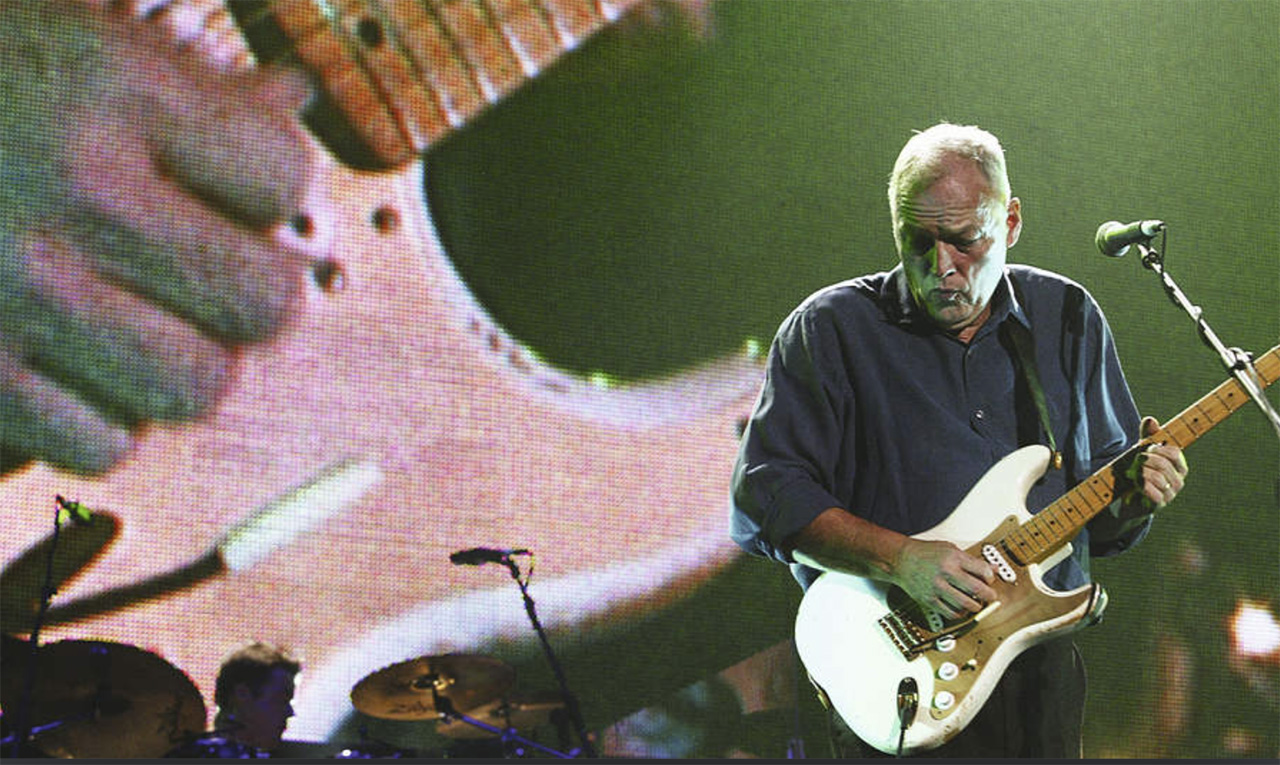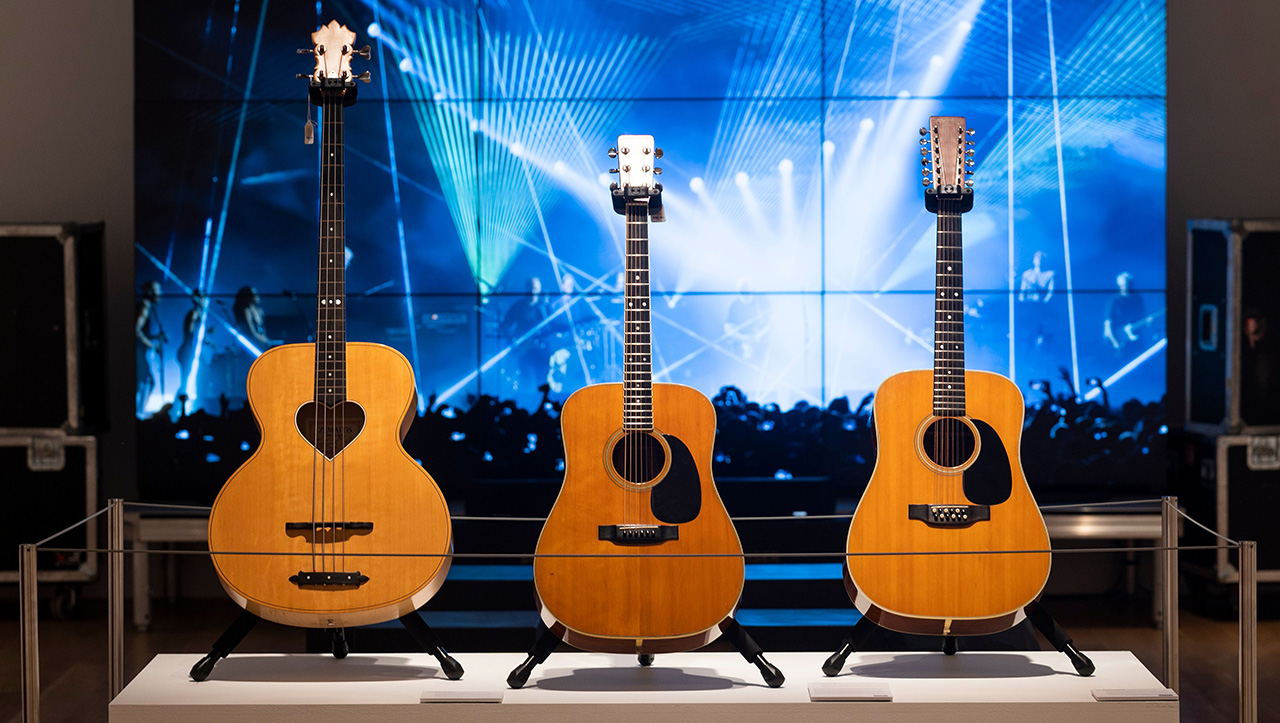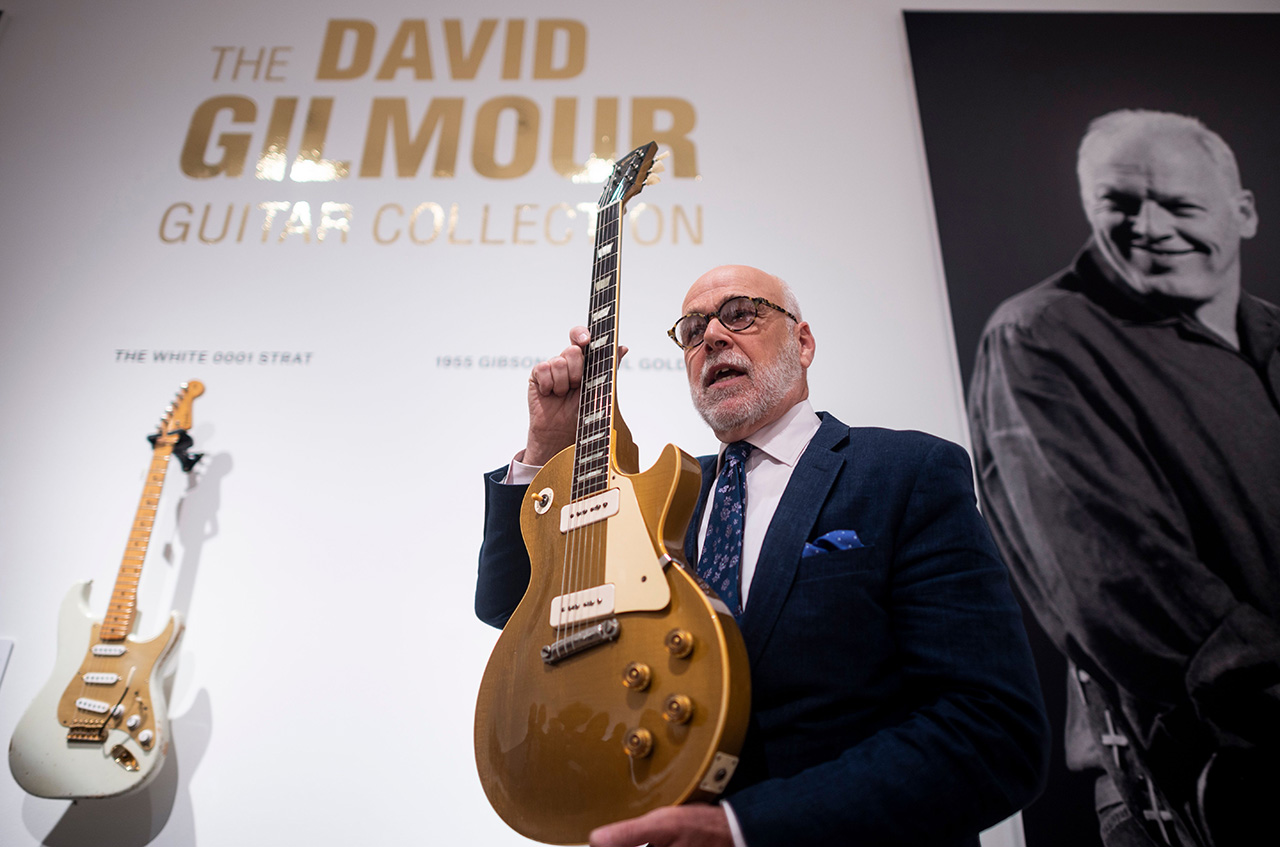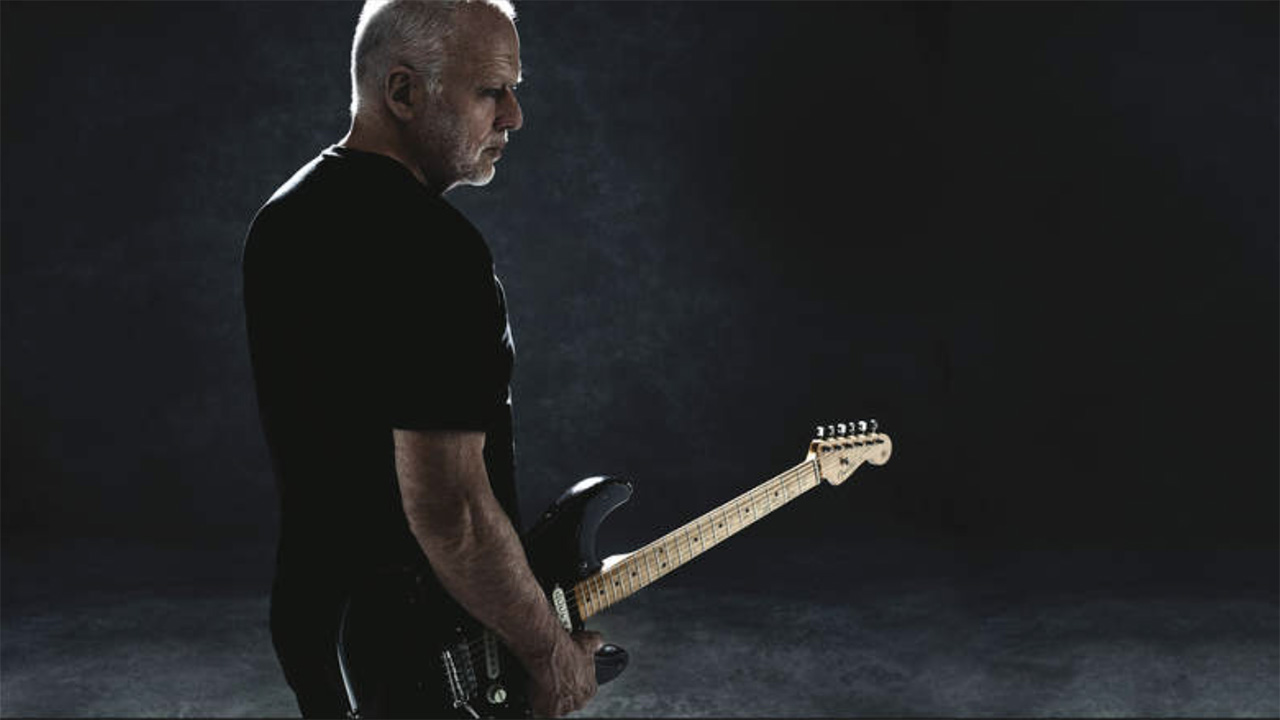In 2019 David Gilmour made the shock announcement that he’d decided to sell 123 of his guitars at auction, many of them legendary among Pink Floyd fans. The move led to all kinds of speculation about his future. He’d eventually raise $21.5m (about £16.6m) for the ClientEarth charity in a record-breaking event; but before it took place, he talked – and played – through some of the unique lots with Prog, and offered some hope for those who feared he might be retiring.
“I’ve no intention of going and doing a Pink Floyd record or a Pink Floyd tour again.” Words from the mouth of David Gilmour that won’t come as a massive surprise to fans, but are still likely to be met by a sinking of many hearts in Progland. Earlier in 2019, the guitarist also announced he was selling around 120 of his own guitars to raise money for charity, a collection that includes the legendary Black Strat that was used on all Floyd albums from 1970 to the mid-80s, and again at the Live 8 reunion; the equally legendary 0001 Strat; and Gilmour’s 1955 Les Paul Goldtop that was used on both The Wall and A Momentary Lapse Of Reason.
One can understand a certain frisson of fear creeping through the Floyd/Gilmour fanbase. What on earth is going on, Mr Gilmour? Does selling so many guitars equate to an announcement of retirement for a man whose guitar tone has coloured the lives of millions of music fans the world over?
Christies, the auction house reselling the Gilmour collection, said his guitar solos were “both lyrical and layered with color, and immediately identifiable to critics and pop music fans as readily as the brushstrokes of Monet’s water lilies are to art historians.” For many (Prog’s editor, for example), the solo in Comfortably Numb remains the finest moment of the finest song on the finest album ever.
“There’s a purpose to what’s going on here,” Gilmour says. “We’re selling the guitars – it'll do good. I could do without one or two guitars here and there; one or two guitars that I use less. I think, ‘Just do it. Get it done.’ If I find that I need something, I'll hunt down the person that bought it and buy it back, or I'll buy another one that’s almost identical. The second option's much more likely.”
Gilmour is, of course, no stranger to grandiose charitable gestures. In 2003 he sold his £3.6 million house in London's Little Venice to Earl Spencer, brother of the late Princess Diana, and gave the proceeds to the homeless charity Crisis, for whom he acts as a vice president. He once donated £25,000 to the Save The Rhino foundation at the behest of Douglas Adams, in return for the author’s invention of album title The Division Bell.
And yet there’s something inherently more personal about a guitar collection: instruments through which this mercurial musician has coloured some of the rock world’s most memorable moments – moments of personal triumph even, in the ongoing battle for the heart of Pink Floyd. Even if Gilmour’s words hint at a continuation of making music, there seems something horribly definite about selling so many of the things that connect him to music lovers the world over.
“These are instruments that have served me very well,” he says. “They have given me music, I’ve loved them, but now it’s time for them to go off and be part of someone else’s musical life. I’m hoping they’ll inspire music in other people. And selling them will hopefully give a fair bit of cash to a number of charities which are in deep need of that cash right at this moment.”
Let’s start with the Black Strat. How old is this instrument?
The Black Strat – my main tool of the trade for the last... God knows how long. I believe it was made in 1969 and I bought it at Manny’s in 48th Street New York in 1970. And it’s been on most Pink Floyd recordings from then up into the 80s, when I put it out to pasture for a while. But then I brought it back again and it’s still the guitar I play more than any other.
Manny’s was fantastic; a brilliant shop. The guy who ran it was called Henry, not Manny. He was a great guy; he would troop off to a back room and dig out a guitar and say, ‘Try this!’ We mostly got new guitars from Manny’s; he had the pick of the crop.
The four notes at the beginning of Shine On You Crazy Diamond popped out of this very guitar… It’s definitely earned its keep
Have you always been that person in the shop gazing out across the various instruments, unable to stop yourself getting another one?
Quite a bit, yes. In Cambridge when I was a teenager and there was no way I could afford a Fender of any sort, there was a music shop called Ken Stevens; I used to spend a lot of time in it. It was a miniature shop – one of those ones where it was only half the width of a usual shopfront, probably only seven or eight foot wide. But there were guitars all the way down both sides, and there was a Stratocaster hanging in there for years, which we sometimes persuaded the guy in the shop to let us touch and play a tune or two on. But I could never afford it.
When you’re in a music shop, when you’re testing out a guitar, what do you play? People will go into guitar shops and test guitars by playing your stuff!
I haven’t been into a guitar shop for quite a while – it’s not the way it works any more. My people talk to their people and the guitars come and you play them and put them back in the box and send them away. There are places in England where they have a range of beautiful old guitars that you can go and see and play and buy. One is an acoustic place I’m going to go to quite soon, with a bit of luck, in Kent.

The first Floyd material the Black Strat appeared on is Meddle – the album many see as the template for the Floyd that would come after that point. So this guitar comes in at the same time. Did it feel like that?
It didn’t feel like that guitar had created that change, no; that would be being a little sparing of the truth. But it became my main guitar, the one I used pretty much on everything, unless there was a reason to want a different sound. So that’s definitely on Meddle, it’s on Dark Side Of The Moon, Comfortably Numb. The four notes at the beginning of Shine On You Crazy Diamond popped out of this very guitar [he plays a short part on it], because it was there and in my hands! What can you say? It’s definitely earned its keep.
If you look at the composite bits it’s probably only worth a couple of grand, but it’s got this status that you’re now using for a good cause. You wouldn’t call it a particularly iconic historical instrument, would you – apart from your association?
I have a duality about my teenage lust to have a Fender Stratocaster, and then having one and thinking, ‘It’s a tool of my trade… get another one’
No, it’s a 1969 Fender Stratocaster, of which thousands and thousands were made. The actual lump of wood that the body is made out of wasn’t always the same type of wood – some are made of alder, some are made of other things. Sometimes you get a bit of wood that’s really light, sometimes you get a bit of wood that’s really heavy. They’re all different. If you pick one up without plugging it in and play it and it feels and sounds great, then it’s gonna sound great amplified, too. This one happened to be in the right place at the right time.
When you retired it, it hung on the wall of the Hard Rock Café in Dallas. Of course, it’s nice that people can see it – but did it grate you a bit thinking, “It’s not being played?”
I have a duality about it, about my affection for it, my teenage lust to have a Fender Stratocaster, and then having one and thinking, “Well you know, it’s a tool of my trade; it’s just a guitar. Get another one, what’s the difference?” And I did get the red one, which has EMG pickups on it, which are battery-powered – it doesn’t react to all the gear, hums and buzzes. Throughout our early time touring, one of the biggest problems was hums and buzzes that the guitar picked up, single coil particularly.
That’s why humbucker pickups are called humbuckers, because they buck that hum. Single coils pick up everything. You’re constantly moving the guitar around two inches, pointing it this way and having to play whole songs that are pointing a certain angle, because if you’re doing it three inches that way, this hum would come up.
Every time you turn on an effects pedal that hum is magnified by 20. And with all those light rigs and stuff that we toured with, it was a constant battle. Our guys would be there in the daytime setting up the gear and they would spend hours trying to pinpoint everything that could make a hum or a buzz and get rid of it, but it was a nightmare. Getting these different electronic pickups got rid of all that in a second, so it made touring life for them and for me much easier.
They were very nervous; they were going to have to mix Hendrix’s sound. I did some mixing stuff in those days and they said, ‘Help! Help!’ so I did.
Did you ever have that Spinal Tap moment where you picked up a local radio station or something?
Yeah! And taxis – people asking for a taxi, they’d come straight through the guitar.
There’s a mythology around a strap that you’ve used on that guitar, more recently on your last tour. Is the myth true?
The myth? Well, my lovely wife Polly Samson bought me, as a present, a Jimi Hendrix strap, that you can see. The strap that he’s wearing at a lot of his later shows, at the Isle Of Wight in 1970 – which I helped mix the sound for. Not a lot of people know that. From the side of the stage on WEM Audiomasters with Charlie Watkins.
What do you recall from that gig?
I went down and I was camping in a tent, just being a punter, and I went backstage where our main roadie, Peter Watts, was trying to deal with all the mayhem with Charlie Watkins of WEM. They were very nervous; they were going to have to mix Hendrix’s sound. I did some mixing stuff in those days and they said, ‘Help! Help!’ so I did.
Did you chat to Hendrix much?
Not then. I had met him previous to that, once. I didn’t know him.

Let’s talk about the acoustics next – we’ll do the Martins. You’ve always had a love for acoustic music, for folk music and early blues. Was the love for acoustic guitars there before you fell in love with electric guitars?
Most people are going to start off on an acoustic guitar. I started off on a nylon-strung acoustic and then graduated to an archtop guitar with F-holes. My background in music is very, very mixed, very broad; I’m a Jack of all trades. I loved acoustic music, I loved folk music, I loved acoustic blues music. Lead Belly was a favourite of mine. Lead Belly had a 12-string; I had a 12-string when I was a teenager, about 19, for a while.
I’ve racked my memory to try and remember what happened to the guitars I had at that time. In some cases I can only imagine that, when I wanted to get another guitar, I had to sell that one to raise the funds. Anyway, I had a 12-string back then and I did very much like Lead Belly’s playing. And a guy called Erik Darling I was very keen on who played 12-string – I had a bit of stuff from him.
One of the musicians my brother’s band at the time – a temporary musician, very temporary in this case – had half-inched the guitars. We got most of them back
So, the two Martins… I bought one from a friend in England. Dunno why he wanted to sell it, but I wanted a 12-string and I didn’t have one at that time so I got this one. Sounds nice! [He plays the start of Wish You Were Here]. So that fell out of this guitar in the control room of Number 3 at Abbey Road in ’75. The people around me picked up on it, and so evolved Wish You Were Here.
There’s a bit of mythology around various cables being taken out of studios and run into cars, and run back again and put through car radios. What’s the start of that track, the sound of that guitar?
The track was supposed to be imitating the sound of a car radio, music being played coming out of a radio, supposedly into someone’s bed sitting room; and the guy in the room joins in and starts playing those melody lines over the top. We did actually run a microphone out into my car in the car park at the front of Abbey Road. I just twiddled with the dial. We recorded some stuff of twiddling with the dial and the changing of stations and used a bit of it on Wish You Were Here.

These strange things happen – it’s the weirdest synchronicity that you get, those strange voices saying weird things and then moving to a different bit. We did it again on The Wall album, exactly the same thing (‘Surprise surprise surprise’). You know you’re gonna get something fantastic. Nowadays, of course, you press a button to change channels between stations. I don’t think it would quite work these days, but in those days you just turned the thing and it gradually went from one into the next one.
Is it true that that guitar was stolen but then later returned to you?
Yeah. I lived out in the countryside somewhere and I had a little studio room. My brother had a band and he was in there rehearsing quite a bit, and these guitars were in that studio room. It was locked and everything; and one night it got broken into and some guitars went. It turned out to be one of the musicians who was in my brother’s band at the time – a temporary musician, very temporary in this case – had half-inched them.
I hope someone who genuinely wants to play them and maybe create something with them is going to buy them. But I don’t really believe that’s going to happen
They were put into a studio in Surrey, owned by Nigel Gray. He recognised the guitar and called us. He said, “I’ve got a sneaking suspicion there are some guitars here that might not belong to the person who brought them here.” We got most of them back. There were a couple that I never got back, one of which was a three-pickup black Les Paul with humbuckers on it, which I’d loved after seeing it on the cover of a Smokey Robinson and The Miracles record. And a Gibson Les Paul TV model, a little blond thing with double cutaways, that I didn’t get back either.
Who do you think is going to buy these guitars?
I hope someone who genuinely wants to play them and have some fun with them and maybe create something with them is going to buy them. But I don’t really believe that’s going to happen. They should be looked after; they should be played and passed on at the appropriate moment – which is now for me.
Have you had many people enquiring? You know, friends or fellow collectors going, “Could you...? How much...?”
I’ve told people about the instruments, but I haven’t had people enquiring with a view to buying them, really. The sort of people I know aren’t going to be the ones who want to buy these things.
What guitar are we going to end with?
This is a white Fender Stratocaster, made in 1954 with sort of gold bits on it. It had gold tuning pegs, but they don’t seem to be on it any more. Gold scratch plate, gold plate on the back with 0001 on it; I’ve had it since 1978. It was made by a friend of Leo Fender’s called Rex Gallion. He was the guy who suggested the scalloping out of the Stratocaster body and the shaping of it so that it would better fit someone’s frame as they were playing it.
I don’t know what his frame was like – maybe a bit like mine. It was a very good idea. Leo Fender gave him this guitar in around ’54, ’55. It’s a very, very beautiful instrument – but he was a Gibson man, it turns out, and so he didn’t really play it very much at all and eventually sold it, I believe, in order to buy a tape recorder. It was then in the window of a store somewhere in California and it was bought by a guy to give to his son for Christmas when he was 12. The years went by, mysterious things happened; and in ’78, I got it. And here it is. It is actually as good a Strat as I’ve ever played. Beautiful.
For me, there has been no real improvement in the making of the electric guitar since this was made in 1954. I would be as happy to play this electric guitar as any other electric guitar, out of all the other ones I’ve looked at and been asked to try over the years. How do you improve on perfection?
Do they have names?
Pardon?
Have you given them names, your guitars?
No.
Because it’s reasonably common for musicians to name, be it a Lucille or whatever.
I’ve never quite done that.
Why not?
Tools of the trade, mate! I guess I have a different form of romanticism.
Has anyone ever tried to steal that one? Does it travel under lock and key? Does it get its own plane seat?
Well, it doesn’t really travel. It moves from this studio to a studio in another house or something; not great distances. It usually just gets chucked in the boot of the car. There’s no massive security around it, no more than any other guitar. I’m lucky – it hasn’t been filched yet.

Do you ever lend these guitars to anyone? Does anyone ever go, “Do you think we could borrow 0001?”
I don’t know if I’ve lent the 0001 guitar out. I’ve lent all sorts of other guitars out to friends. They give them back.
I sense there is a dichotomy here... How are you going to feel when you’re in the auction house and you see these instruments in front of you and you see the money being bid?
Obviously there’s going to be a dual feeling from a little bit of loss but a huge sense of relief, in that I don’t have to think about what’s going to happen to them in the future. I’ve had my time with them. I’m finding new friends now and they can move on, and they’ll do an enormous amount of good. I don’t think it’s something I’m going to have to struggle with in a major way. I don’t think I’m going to have to see my shrink for weeks and months and years to deal with this.
Finally, what’s next aside from this auction? Are your eyes set on a new musical horizon?
I’m seeing if I get my appetite back to start recording a proper album and doing all the stuff that goes with it
I write bits of music. I work. I haven’t done much lately. Other things in my life are tidying up a little bit, one might say, at the moment. Clear space is coming up to me. I’ll be getting into this studio we’re sitting in at the moment and listening to the hundreds of little bits of demos that I’ve got, and developing them; seeing where they go and seeing if I get my appetite back to start recording a proper album and doing all the stuff that goes with it.
Entering into that, for me, is about a four-year project – the writing, the refining, the recording. The marketing of an album and doing a tour, preparing for rehearsals, getting the musicians, all that shit, takes a lot of time. I usually find at the end that it’s taken me about four years to do the whole thing, so it’s a commitment which I have as yet to make. But we’ll probably get there.
During the auction at Christies in New York, the Martin acoustic, with an expected sale price of $20,000, went for $1,095,000; the white Strat, expected at $150,000, went for $1,815,000; and the Black Strat, also expected to raise $150,000, became a record-setting transaction at $3,975,000.




